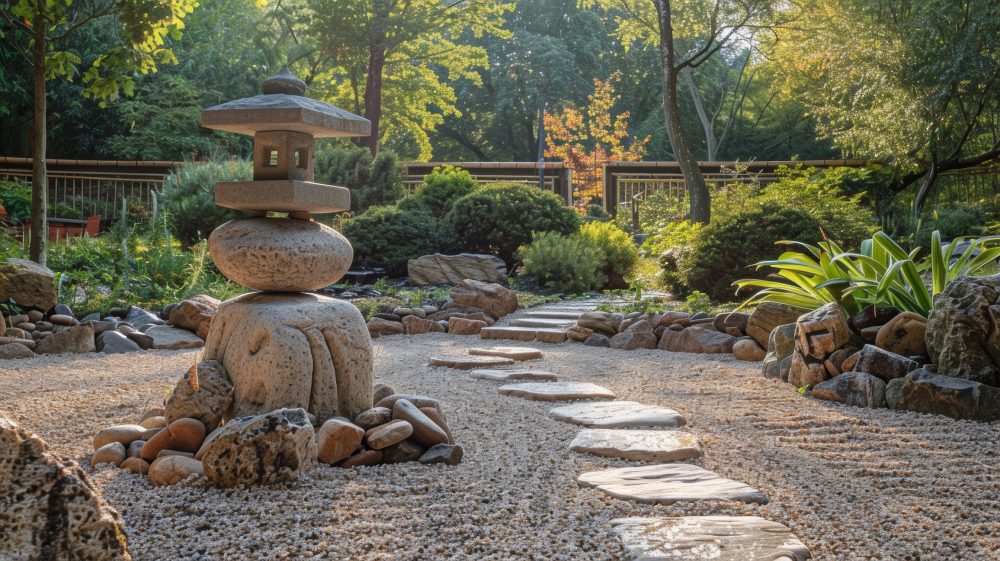It’s amazing how only the addition of a Zen Garden can make a house the ultimate source of peace and tranquility. Creating an outdoor mindfulness area does indeed engender not only mental well-being but also harmony in a person’s daily life. Below, we are going to present how to cultivate mindfulness with the creation of a Zen Garden by sharing some tips on design, what elements to include in it, and how to take care of such a tranquil space.
Understanding the Concept of Zen Garden
A Zen Garden, otherwise known as a Japanese rock garden, is a highly minimalist landscape featuring mostly sand, stones, and well-placed plants. The simplicity of such a design invites contemplation and meditation, making it an ideal setting for practicing mindfulness. Raking the sand into patterns, placing stones, or just sitting in this garden can quiet the mind and foster a closer connection to the present moment.
Begin by considering the design and size of your Zen Garden. You can fit one in any size yard. The key to pulling this off will be creating a layout that feels balanced and soothing, with natural materials worked in through minimalist design principles.
Basic Elements of a Zen Garden
When designing your Zen Garden, here are a few things you should include.
-
- Sand or Gravel: These are the usual materials for the base of your Zen Garden. The patterns raked present water and have been an important constituent part of the gardens for meditation purposes.
- Stones: These represent mountains or islands and are the major focal points in a Zen Garden. They are intentionally placed so they can evoke a sense of balance and natural beauty.
- Plants: Even though the Zen gardens should usually be minimalistic, a few well-chosen plants might favor the outdoors’ tranquility atmosphere. Evergreen shrubs, moss, and bamboo are traditional Japanese garden plants that you can consider for your landscape.
- Water Features: Not always included but often a feature, a water feature such as a small fountain can add to the peacefulness of your Zen Garden. If anything, the trickling of the water is considered soothing and further encourages mindfulness.
Less is often more when it comes to the planning of the garden-think of an inviting space that fosters the relaxation and mindfulness so needed. For more inspiration on how to create environments that support well-being, take a look at ideas on how to bring more joy into your life, considerations that certainly apply to the mindful design of your outdoor spaces, too.
Mindfulness Practice Incorporation
Now that you have your Zen garden set up, it is an ideal setting in which to practice mindfulness. Here are a few ways that you might use the mindfulness component in your time spent in the garden.
-
- Meditate: Turn your Zen Garden into a meditation spot by sitting quietly, taking slow breaths, and letting the simplicity in everything around you free your mind.
- Raking Patterns: They are a kind of meditation in themselves. As one is tracing swirls and lines in the sand, pay attention to the motion at hand and let go of distracting thoughts.
- Mindful Observation: Observe everything going on in your garden, from the texture of the stones to where the light hits the sand to the gentle movements of the plants in a breeze. This really helps anchor you into the present moment.
It is also a mindfulness when keeping your Zen Garden. Regular raking of the sand or pruning of the plants in a space gives one more contact with the garden. This allows the process of tending of your garden to be part of your discipline of mindfulness, hence offering more and more moments for reflection and tranquility.
Expanding Your Outdoor Sanctuary
While a Zen Garden can indeed be an effective space in cultivating your mindfulness, you can further create an outdoor space into an increasingly holistic haven: a place to sit down and read, do some journaling, or create a path through your garden you can take for some walking meditation. This should be a setting supportive of your journey toward an increasingly mindful and more intentional life.
If you want to add some features to the garden, such as a path or a quiet seating area built into a deck, it can transform the space further. A quick ‘deck builder near me’ Google search can help you find a builder who will construct an awesome-looking garden that would complement your mindfulness sessions perfectly.
Finally, remember that the acts of mindfulness you practice in your garden can spill into other areas of your life. Designing spaces for mindfulness, along with daily habits and mindset, can breed more peace and fulfillment in life and help in exploring ways to fall in love with your life.
Make Everything Zen
It is not only about landscaping, but a Zen Garden is planted to make an environment that encourages mindfulness, allowing one to take some serenity back into the daily routine. Embrace the simplicity of a Zen Garden and allow it to be where you can retreat, reflect, and recharge.
Want to Learn How to Love Your Life No Matter What is Happening?
Snag a free workbook and get inspiration on all the ways to love your life even more.









